B.Tech Engineering: Sewage Water Recycling Project - Amity Dubai
VerifiedAdded on 2023/04/21
|21
|4803
|277
Project
AI Summary
This document presents a minor project report focused on recycling sewage water into treated effluent, submitted to Amity University Dubai in partial fulfillment of the requirements for a Bachelor of Technology degree in an unspecified engineering field. The project aims to improve water quality by removing undesirable impurities, making it suitable for various uses. The report includes an introduction outlining the project's objectives and background, a literature review of existing research on sewage water reuse, and detailed project specifics such as aims, scope, constraints, and management approach. Furthermore, it provides a project timeline, roles and responsibilities, risk assessment, analysis, and feasibility. The report also touches on the results, discussion, applications, future prospects, cost analysis, and a conclusion, providing a comprehensive overview of the sewage water recycling project.
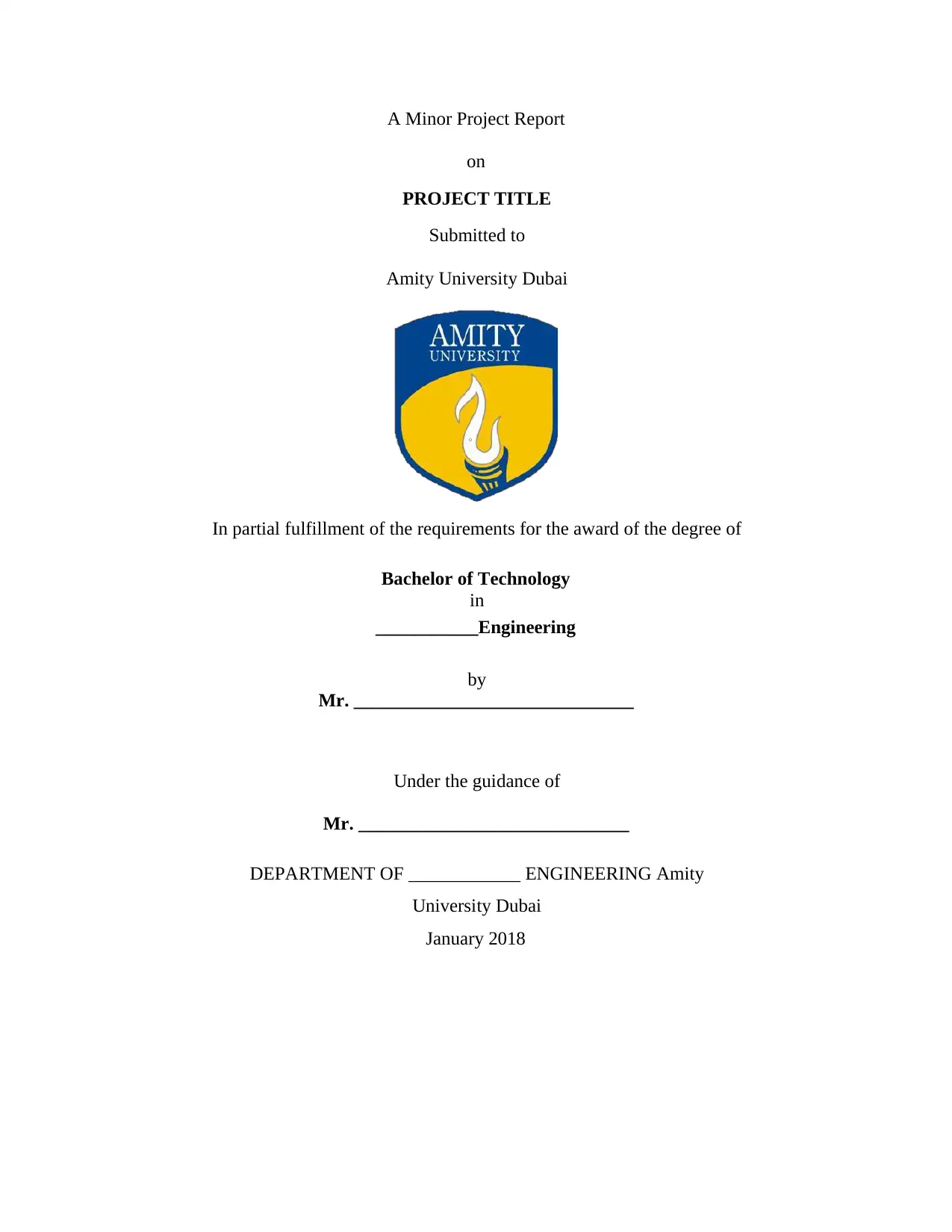
A Minor Project Report
on
PROJECT TITLE
Submitted to
Amity University Dubai
In partial fulfillment of the requirements for the award of the degree of
Bachelor of Technology
in
___________Engineering
by
Mr. ______________________________
Under the guidance of
Mr. _____________________________
DEPARTMENT OF ____________ ENGINEERING Amity
University Dubai
January 2018
on
PROJECT TITLE
Submitted to
Amity University Dubai
In partial fulfillment of the requirements for the award of the degree of
Bachelor of Technology
in
___________Engineering
by
Mr. ______________________________
Under the guidance of
Mr. _____________________________
DEPARTMENT OF ____________ ENGINEERING Amity
University Dubai
January 2018
Paraphrase This Document
Need a fresh take? Get an instant paraphrase of this document with our AI Paraphraser
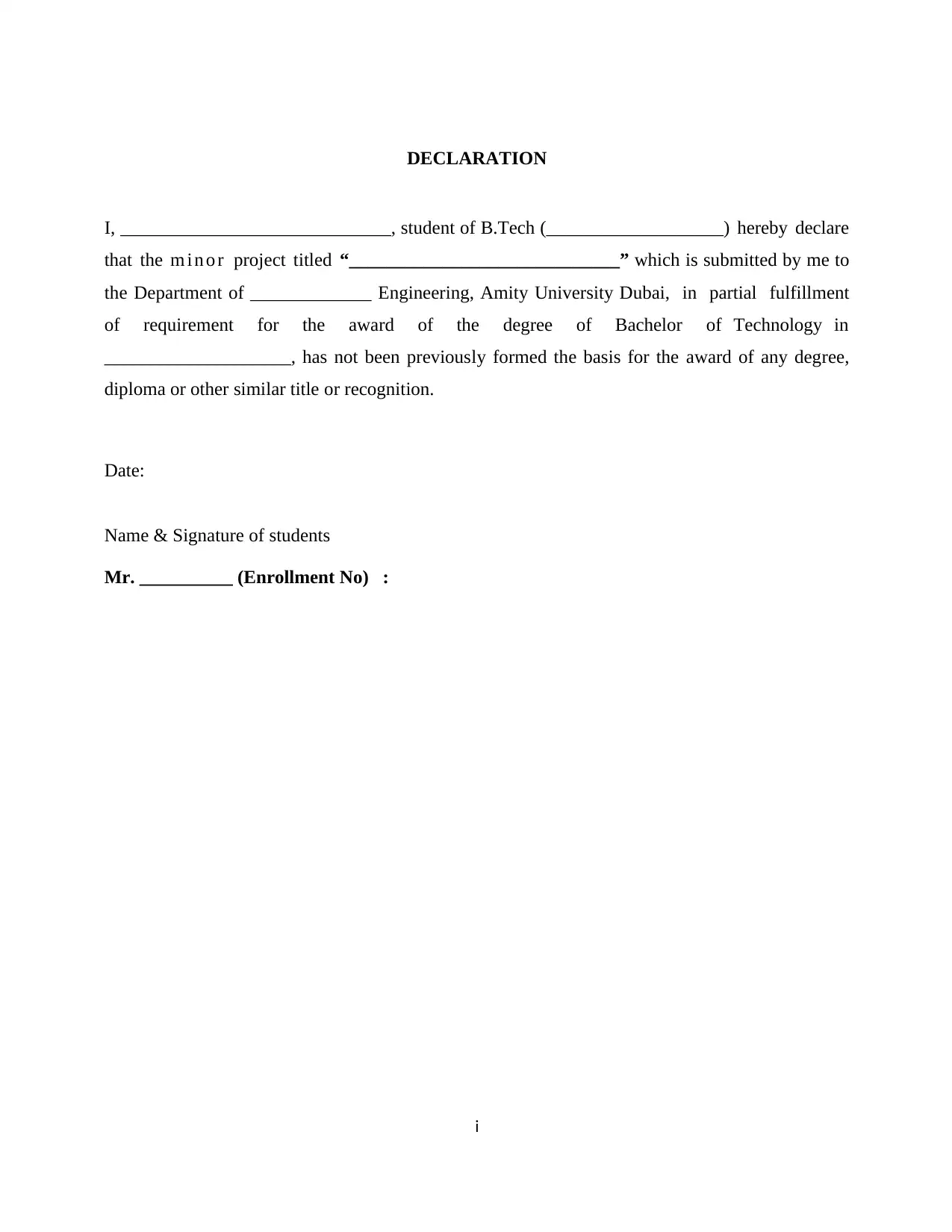
DECLARATION
I, _____________________________, student of B.Tech (___________________) hereby declare
that the m i n o r project titled “_____________________________” which is submitted by me to
the Department of _____________ Engineering, Amity University Dubai, in partial fulfillment
of requirement for the award of the degree of Bachelor of Technology in
____________________, has not been previously formed the basis for the award of any degree,
diploma or other similar title or recognition.
Date:
Name & Signature of students
Mr. __________ (Enrollment No) :
i
I, _____________________________, student of B.Tech (___________________) hereby declare
that the m i n o r project titled “_____________________________” which is submitted by me to
the Department of _____________ Engineering, Amity University Dubai, in partial fulfillment
of requirement for the award of the degree of Bachelor of Technology in
____________________, has not been previously formed the basis for the award of any degree,
diploma or other similar title or recognition.
Date:
Name & Signature of students
Mr. __________ (Enrollment No) :
i
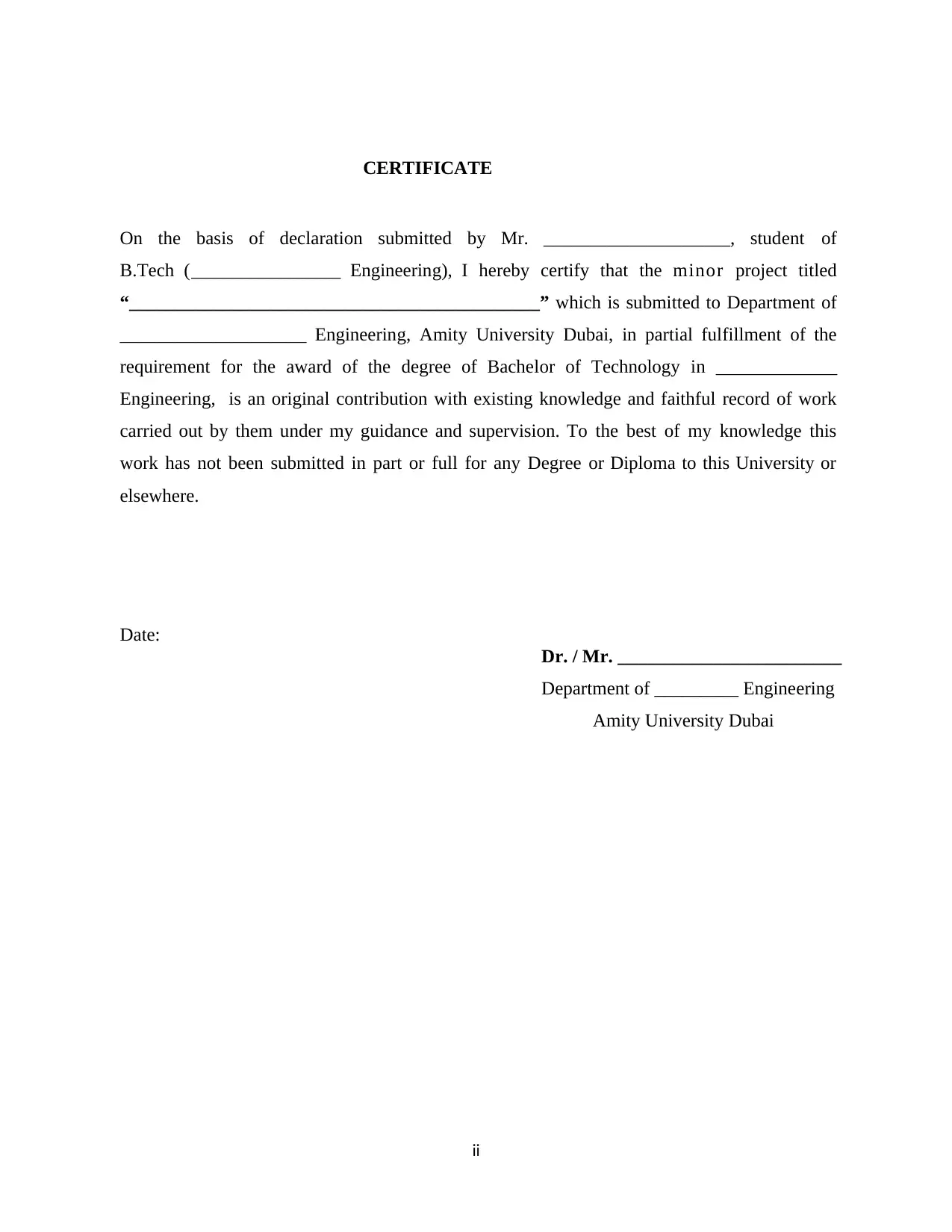
CERTIFICATE
On the basis of declaration submitted by Mr. ____________________, student of
B.Tech (________________ Engineering), I hereby certify that the minor project titled
“____________________________________________” which is submitted to Department of
____________________ Engineering, Amity University Dubai, in partial fulfillment of the
requirement for the award of the degree of Bachelor of Technology in _____________
Engineering, is an original contribution with existing knowledge and faithful record of work
carried out by them under my guidance and supervision. To the best of my knowledge this
work has not been submitted in part or full for any Degree or Diploma to this University or
elsewhere.
Date:
Dr. / Mr. ________________________
Department of _________ Engineering
Amity University Dubai
ii
On the basis of declaration submitted by Mr. ____________________, student of
B.Tech (________________ Engineering), I hereby certify that the minor project titled
“____________________________________________” which is submitted to Department of
____________________ Engineering, Amity University Dubai, in partial fulfillment of the
requirement for the award of the degree of Bachelor of Technology in _____________
Engineering, is an original contribution with existing knowledge and faithful record of work
carried out by them under my guidance and supervision. To the best of my knowledge this
work has not been submitted in part or full for any Degree or Diploma to this University or
elsewhere.
Date:
Dr. / Mr. ________________________
Department of _________ Engineering
Amity University Dubai
ii
⊘ This is a preview!⊘
Do you want full access?
Subscribe today to unlock all pages.

Trusted by 1+ million students worldwide
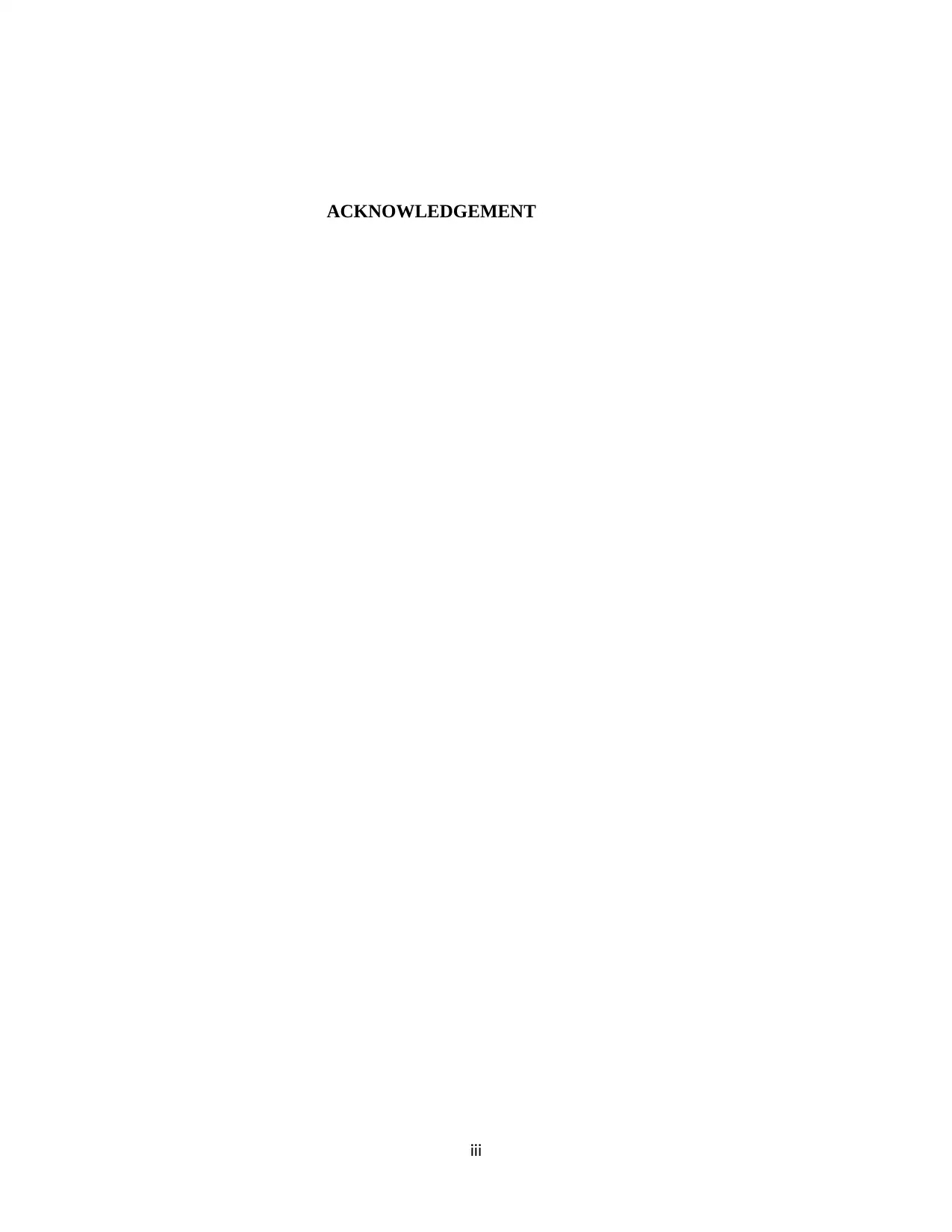
ACKNOWLEDGEMENT
iii
iii
Paraphrase This Document
Need a fresh take? Get an instant paraphrase of this document with our AI Paraphraser
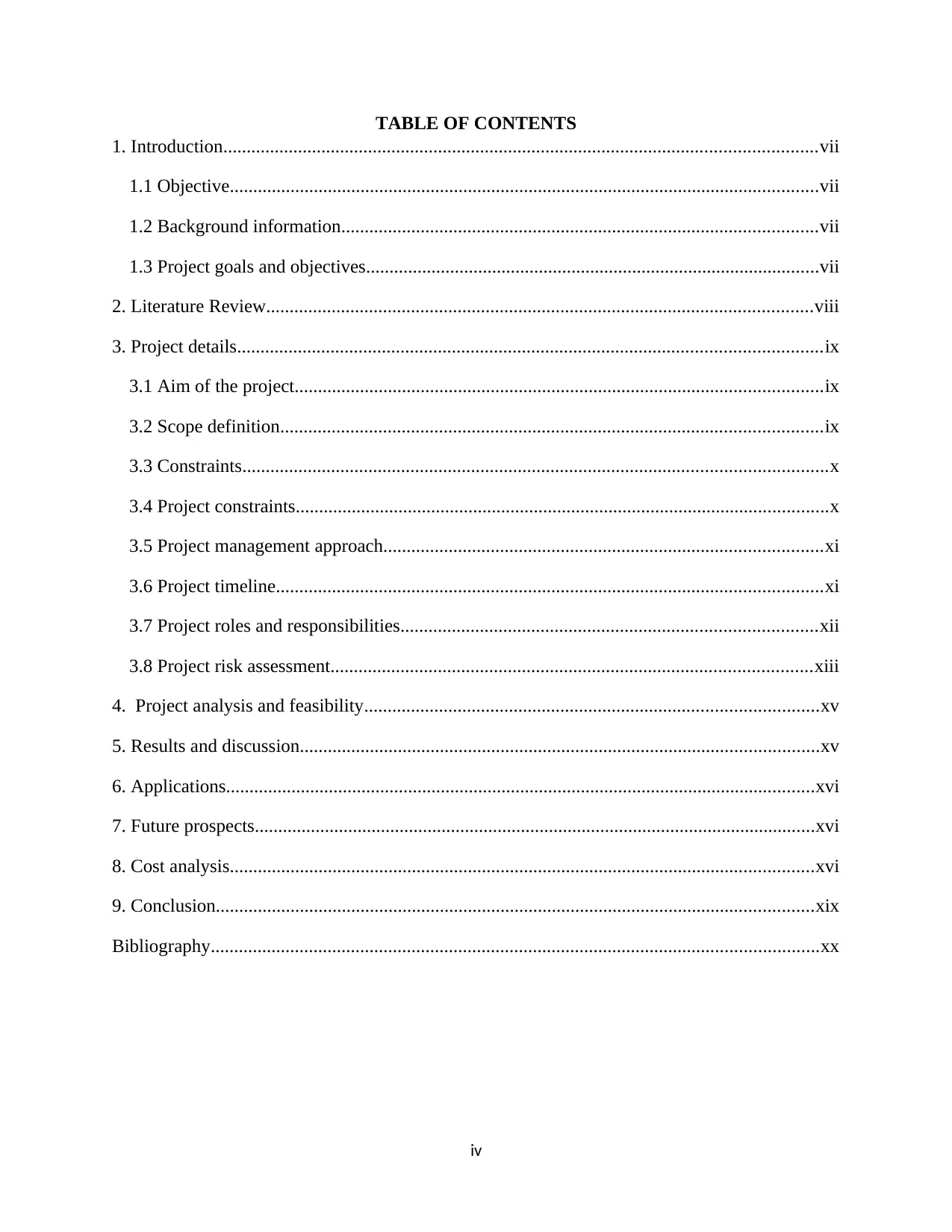
TABLE OF CONTENTS
1. Introduction...............................................................................................................................vii
1.1 Objective..............................................................................................................................vii
1.2 Background information......................................................................................................vii
1.3 Project goals and objectives.................................................................................................vii
2. Literature Review.....................................................................................................................viii
3. Project details.............................................................................................................................ix
3.1 Aim of the project.................................................................................................................ix
3.2 Scope definition....................................................................................................................ix
3.3 Constraints.............................................................................................................................x
3.4 Project constraints..................................................................................................................x
3.5 Project management approach..............................................................................................xi
3.6 Project timeline.....................................................................................................................xi
3.7 Project roles and responsibilities.........................................................................................xii
3.8 Project risk assessment.......................................................................................................xiii
4. Project analysis and feasibility.................................................................................................xv
5. Results and discussion...............................................................................................................xv
6. Applications..............................................................................................................................xvi
7. Future prospects........................................................................................................................xvi
8. Cost analysis.............................................................................................................................xvi
9. Conclusion................................................................................................................................xix
Bibliography..................................................................................................................................xx
iv
1. Introduction...............................................................................................................................vii
1.1 Objective..............................................................................................................................vii
1.2 Background information......................................................................................................vii
1.3 Project goals and objectives.................................................................................................vii
2. Literature Review.....................................................................................................................viii
3. Project details.............................................................................................................................ix
3.1 Aim of the project.................................................................................................................ix
3.2 Scope definition....................................................................................................................ix
3.3 Constraints.............................................................................................................................x
3.4 Project constraints..................................................................................................................x
3.5 Project management approach..............................................................................................xi
3.6 Project timeline.....................................................................................................................xi
3.7 Project roles and responsibilities.........................................................................................xii
3.8 Project risk assessment.......................................................................................................xiii
4. Project analysis and feasibility.................................................................................................xv
5. Results and discussion...............................................................................................................xv
6. Applications..............................................................................................................................xvi
7. Future prospects........................................................................................................................xvi
8. Cost analysis.............................................................................................................................xvi
9. Conclusion................................................................................................................................xix
Bibliography..................................................................................................................................xx
iv
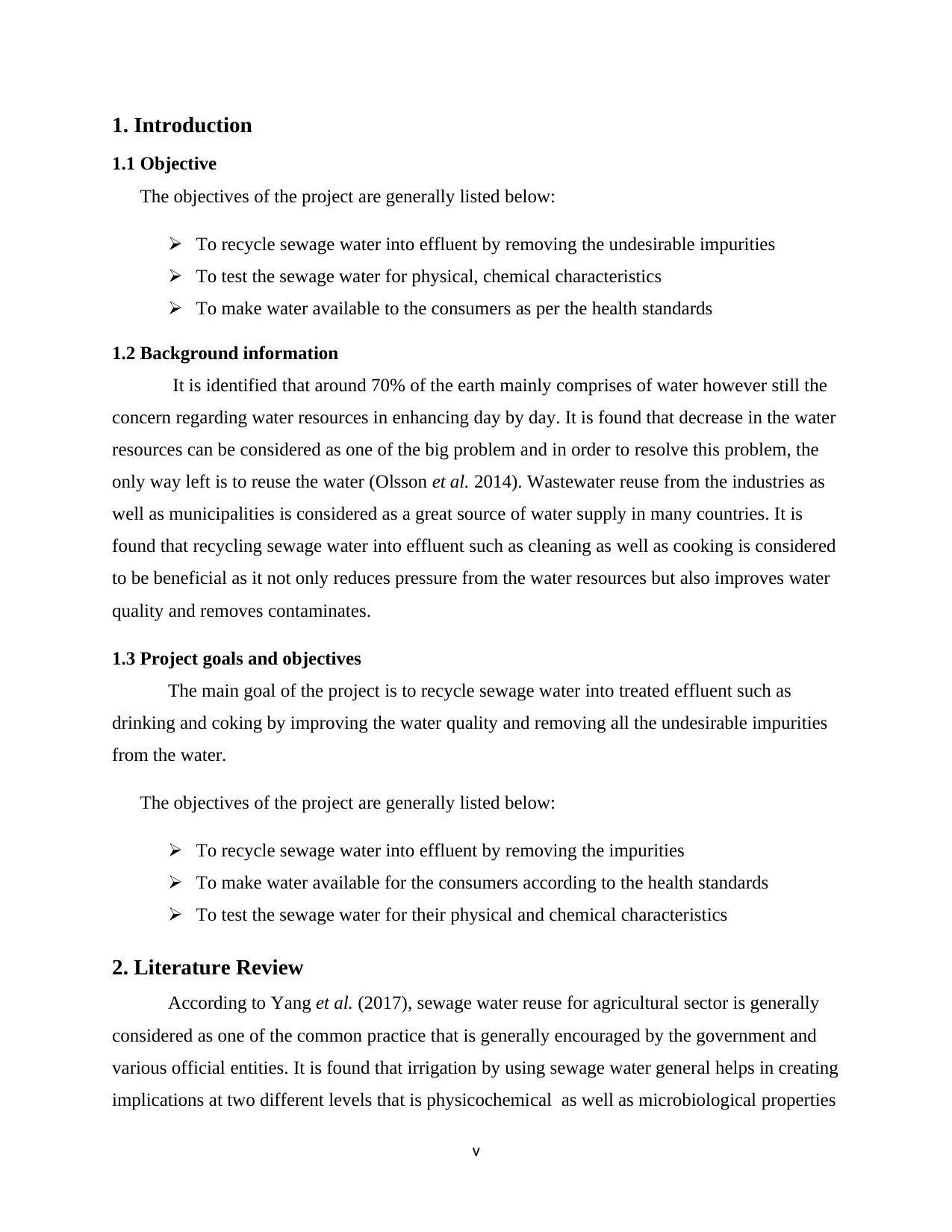
1. Introduction
1.1 Objective
The objectives of the project are generally listed below:
To recycle sewage water into effluent by removing the undesirable impurities
To test the sewage water for physical, chemical characteristics
To make water available to the consumers as per the health standards
1.2 Background information
It is identified that around 70% of the earth mainly comprises of water however still the
concern regarding water resources in enhancing day by day. It is found that decrease in the water
resources can be considered as one of the big problem and in order to resolve this problem, the
only way left is to reuse the water (Olsson et al. 2014). Wastewater reuse from the industries as
well as municipalities is considered as a great source of water supply in many countries. It is
found that recycling sewage water into effluent such as cleaning as well as cooking is considered
to be beneficial as it not only reduces pressure from the water resources but also improves water
quality and removes contaminates.
1.3 Project goals and objectives
The main goal of the project is to recycle sewage water into treated effluent such as
drinking and coking by improving the water quality and removing all the undesirable impurities
from the water.
The objectives of the project are generally listed below:
To recycle sewage water into effluent by removing the impurities
To make water available for the consumers according to the health standards
To test the sewage water for their physical and chemical characteristics
2. Literature Review
According to Yang et al. (2017), sewage water reuse for agricultural sector is generally
considered as one of the common practice that is generally encouraged by the government and
various official entities. It is found that irrigation by using sewage water general helps in creating
implications at two different levels that is physicochemical as well as microbiological properties
v
1.1 Objective
The objectives of the project are generally listed below:
To recycle sewage water into effluent by removing the undesirable impurities
To test the sewage water for physical, chemical characteristics
To make water available to the consumers as per the health standards
1.2 Background information
It is identified that around 70% of the earth mainly comprises of water however still the
concern regarding water resources in enhancing day by day. It is found that decrease in the water
resources can be considered as one of the big problem and in order to resolve this problem, the
only way left is to reuse the water (Olsson et al. 2014). Wastewater reuse from the industries as
well as municipalities is considered as a great source of water supply in many countries. It is
found that recycling sewage water into effluent such as cleaning as well as cooking is considered
to be beneficial as it not only reduces pressure from the water resources but also improves water
quality and removes contaminates.
1.3 Project goals and objectives
The main goal of the project is to recycle sewage water into treated effluent such as
drinking and coking by improving the water quality and removing all the undesirable impurities
from the water.
The objectives of the project are generally listed below:
To recycle sewage water into effluent by removing the impurities
To make water available for the consumers according to the health standards
To test the sewage water for their physical and chemical characteristics
2. Literature Review
According to Yang et al. (2017), sewage water reuse for agricultural sector is generally
considered as one of the common practice that is generally encouraged by the government and
various official entities. It is found that irrigation by using sewage water general helps in creating
implications at two different levels that is physicochemical as well as microbiological properties
v
⊘ This is a preview!⊘
Do you want full access?
Subscribe today to unlock all pages.

Trusted by 1+ million students worldwide
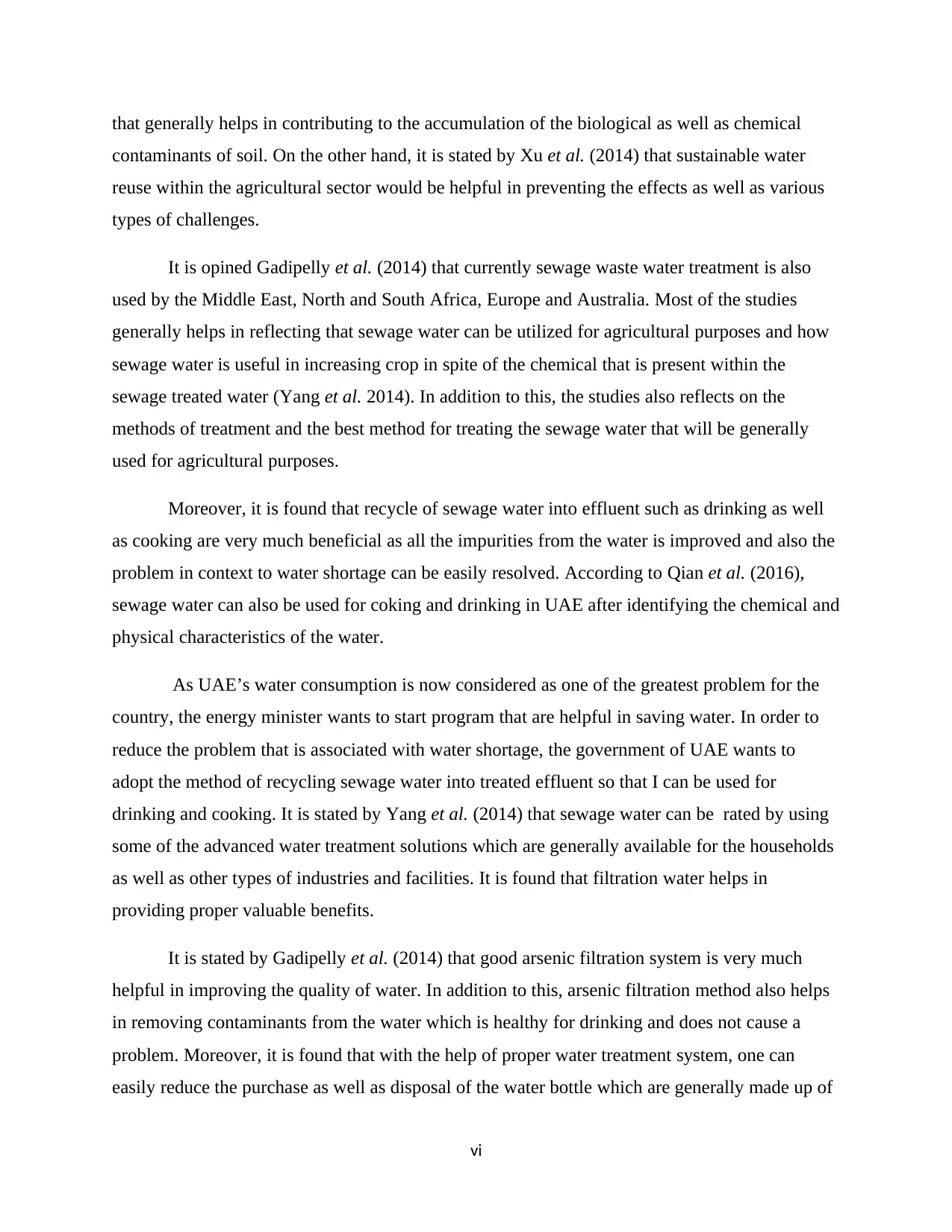
that generally helps in contributing to the accumulation of the biological as well as chemical
contaminants of soil. On the other hand, it is stated by Xu et al. (2014) that sustainable water
reuse within the agricultural sector would be helpful in preventing the effects as well as various
types of challenges.
It is opined Gadipelly et al. (2014) that currently sewage waste water treatment is also
used by the Middle East, North and South Africa, Europe and Australia. Most of the studies
generally helps in reflecting that sewage water can be utilized for agricultural purposes and how
sewage water is useful in increasing crop in spite of the chemical that is present within the
sewage treated water (Yang et al. 2014). In addition to this, the studies also reflects on the
methods of treatment and the best method for treating the sewage water that will be generally
used for agricultural purposes.
Moreover, it is found that recycle of sewage water into effluent such as drinking as well
as cooking are very much beneficial as all the impurities from the water is improved and also the
problem in context to water shortage can be easily resolved. According to Qian et al. (2016),
sewage water can also be used for coking and drinking in UAE after identifying the chemical and
physical characteristics of the water.
As UAE’s water consumption is now considered as one of the greatest problem for the
country, the energy minister wants to start program that are helpful in saving water. In order to
reduce the problem that is associated with water shortage, the government of UAE wants to
adopt the method of recycling sewage water into treated effluent so that I can be used for
drinking and cooking. It is stated by Yang et al. (2014) that sewage water can be rated by using
some of the advanced water treatment solutions which are generally available for the households
as well as other types of industries and facilities. It is found that filtration water helps in
providing proper valuable benefits.
It is stated by Gadipelly et al. (2014) that good arsenic filtration system is very much
helpful in improving the quality of water. In addition to this, arsenic filtration method also helps
in removing contaminants from the water which is healthy for drinking and does not cause a
problem. Moreover, it is found that with the help of proper water treatment system, one can
easily reduce the purchase as well as disposal of the water bottle which are generally made up of
vi
contaminants of soil. On the other hand, it is stated by Xu et al. (2014) that sustainable water
reuse within the agricultural sector would be helpful in preventing the effects as well as various
types of challenges.
It is opined Gadipelly et al. (2014) that currently sewage waste water treatment is also
used by the Middle East, North and South Africa, Europe and Australia. Most of the studies
generally helps in reflecting that sewage water can be utilized for agricultural purposes and how
sewage water is useful in increasing crop in spite of the chemical that is present within the
sewage treated water (Yang et al. 2014). In addition to this, the studies also reflects on the
methods of treatment and the best method for treating the sewage water that will be generally
used for agricultural purposes.
Moreover, it is found that recycle of sewage water into effluent such as drinking as well
as cooking are very much beneficial as all the impurities from the water is improved and also the
problem in context to water shortage can be easily resolved. According to Qian et al. (2016),
sewage water can also be used for coking and drinking in UAE after identifying the chemical and
physical characteristics of the water.
As UAE’s water consumption is now considered as one of the greatest problem for the
country, the energy minister wants to start program that are helpful in saving water. In order to
reduce the problem that is associated with water shortage, the government of UAE wants to
adopt the method of recycling sewage water into treated effluent so that I can be used for
drinking and cooking. It is stated by Yang et al. (2014) that sewage water can be rated by using
some of the advanced water treatment solutions which are generally available for the households
as well as other types of industries and facilities. It is found that filtration water helps in
providing proper valuable benefits.
It is stated by Gadipelly et al. (2014) that good arsenic filtration system is very much
helpful in improving the quality of water. In addition to this, arsenic filtration method also helps
in removing contaminants from the water which is healthy for drinking and does not cause a
problem. Moreover, it is found that with the help of proper water treatment system, one can
easily reduce the purchase as well as disposal of the water bottle which are generally made up of
vi
Paraphrase This Document
Need a fresh take? Get an instant paraphrase of this document with our AI Paraphraser
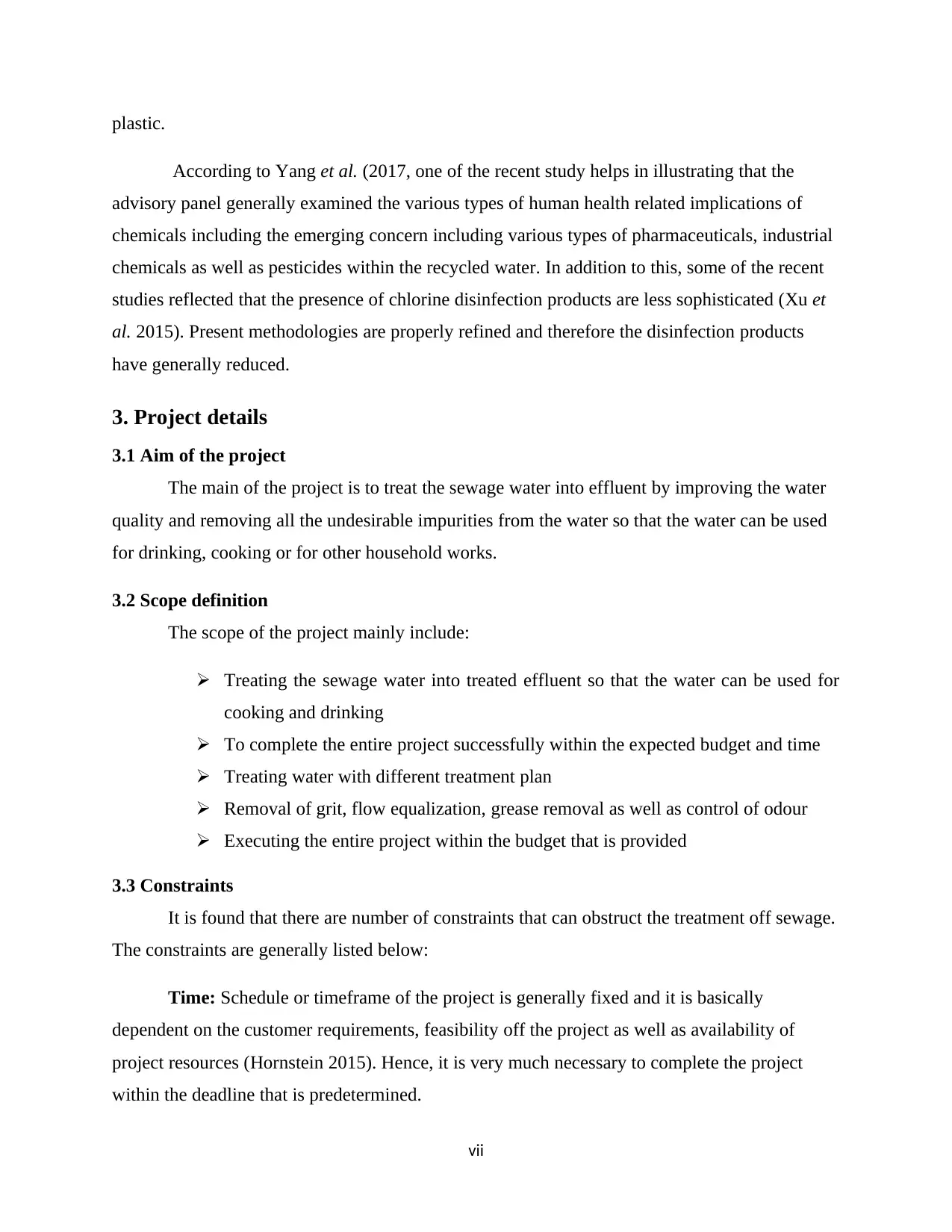
plastic.
According to Yang et al. (2017, one of the recent study helps in illustrating that the
advisory panel generally examined the various types of human health related implications of
chemicals including the emerging concern including various types of pharmaceuticals, industrial
chemicals as well as pesticides within the recycled water. In addition to this, some of the recent
studies reflected that the presence of chlorine disinfection products are less sophisticated (Xu et
al. 2015). Present methodologies are properly refined and therefore the disinfection products
have generally reduced.
3. Project details
3.1 Aim of the project
The main of the project is to treat the sewage water into effluent by improving the water
quality and removing all the undesirable impurities from the water so that the water can be used
for drinking, cooking or for other household works.
3.2 Scope definition
The scope of the project mainly include:
Treating the sewage water into treated effluent so that the water can be used for
cooking and drinking
To complete the entire project successfully within the expected budget and time
Treating water with different treatment plan
Removal of grit, flow equalization, grease removal as well as control of odour
Executing the entire project within the budget that is provided
3.3 Constraints
It is found that there are number of constraints that can obstruct the treatment off sewage.
The constraints are generally listed below:
Time: Schedule or timeframe of the project is generally fixed and it is basically
dependent on the customer requirements, feasibility off the project as well as availability of
project resources (Hornstein 2015). Hence, it is very much necessary to complete the project
within the deadline that is predetermined.
vii
According to Yang et al. (2017, one of the recent study helps in illustrating that the
advisory panel generally examined the various types of human health related implications of
chemicals including the emerging concern including various types of pharmaceuticals, industrial
chemicals as well as pesticides within the recycled water. In addition to this, some of the recent
studies reflected that the presence of chlorine disinfection products are less sophisticated (Xu et
al. 2015). Present methodologies are properly refined and therefore the disinfection products
have generally reduced.
3. Project details
3.1 Aim of the project
The main of the project is to treat the sewage water into effluent by improving the water
quality and removing all the undesirable impurities from the water so that the water can be used
for drinking, cooking or for other household works.
3.2 Scope definition
The scope of the project mainly include:
Treating the sewage water into treated effluent so that the water can be used for
cooking and drinking
To complete the entire project successfully within the expected budget and time
Treating water with different treatment plan
Removal of grit, flow equalization, grease removal as well as control of odour
Executing the entire project within the budget that is provided
3.3 Constraints
It is found that there are number of constraints that can obstruct the treatment off sewage.
The constraints are generally listed below:
Time: Schedule or timeframe of the project is generally fixed and it is basically
dependent on the customer requirements, feasibility off the project as well as availability of
project resources (Hornstein 2015). Hence, it is very much necessary to complete the project
within the deadline that is predetermined.
vii
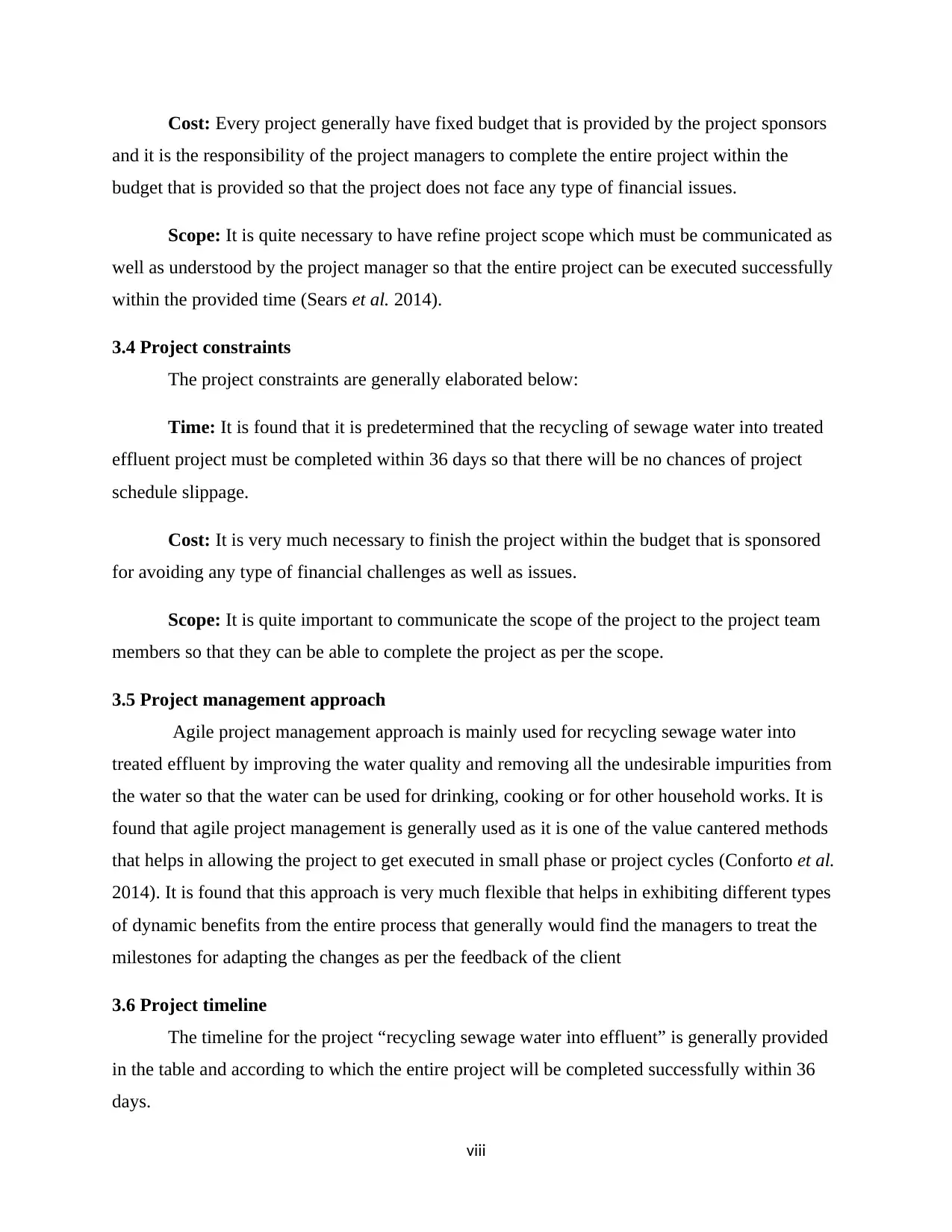
Cost: Every project generally have fixed budget that is provided by the project sponsors
and it is the responsibility of the project managers to complete the entire project within the
budget that is provided so that the project does not face any type of financial issues.
Scope: It is quite necessary to have refine project scope which must be communicated as
well as understood by the project manager so that the entire project can be executed successfully
within the provided time (Sears et al. 2014).
3.4 Project constraints
The project constraints are generally elaborated below:
Time: It is found that it is predetermined that the recycling of sewage water into treated
effluent project must be completed within 36 days so that there will be no chances of project
schedule slippage.
Cost: It is very much necessary to finish the project within the budget that is sponsored
for avoiding any type of financial challenges as well as issues.
Scope: It is quite important to communicate the scope of the project to the project team
members so that they can be able to complete the project as per the scope.
3.5 Project management approach
Agile project management approach is mainly used for recycling sewage water into
treated effluent by improving the water quality and removing all the undesirable impurities from
the water so that the water can be used for drinking, cooking or for other household works. It is
found that agile project management is generally used as it is one of the value cantered methods
that helps in allowing the project to get executed in small phase or project cycles (Conforto et al.
2014). It is found that this approach is very much flexible that helps in exhibiting different types
of dynamic benefits from the entire process that generally would find the managers to treat the
milestones for adapting the changes as per the feedback of the client
3.6 Project timeline
The timeline for the project “recycling sewage water into effluent” is generally provided
in the table and according to which the entire project will be completed successfully within 36
days.
viii
and it is the responsibility of the project managers to complete the entire project within the
budget that is provided so that the project does not face any type of financial issues.
Scope: It is quite necessary to have refine project scope which must be communicated as
well as understood by the project manager so that the entire project can be executed successfully
within the provided time (Sears et al. 2014).
3.4 Project constraints
The project constraints are generally elaborated below:
Time: It is found that it is predetermined that the recycling of sewage water into treated
effluent project must be completed within 36 days so that there will be no chances of project
schedule slippage.
Cost: It is very much necessary to finish the project within the budget that is sponsored
for avoiding any type of financial challenges as well as issues.
Scope: It is quite important to communicate the scope of the project to the project team
members so that they can be able to complete the project as per the scope.
3.5 Project management approach
Agile project management approach is mainly used for recycling sewage water into
treated effluent by improving the water quality and removing all the undesirable impurities from
the water so that the water can be used for drinking, cooking or for other household works. It is
found that agile project management is generally used as it is one of the value cantered methods
that helps in allowing the project to get executed in small phase or project cycles (Conforto et al.
2014). It is found that this approach is very much flexible that helps in exhibiting different types
of dynamic benefits from the entire process that generally would find the managers to treat the
milestones for adapting the changes as per the feedback of the client
3.6 Project timeline
The timeline for the project “recycling sewage water into effluent” is generally provided
in the table and according to which the entire project will be completed successfully within 36
days.
viii
⊘ This is a preview!⊘
Do you want full access?
Subscribe today to unlock all pages.

Trusted by 1+ million students worldwide
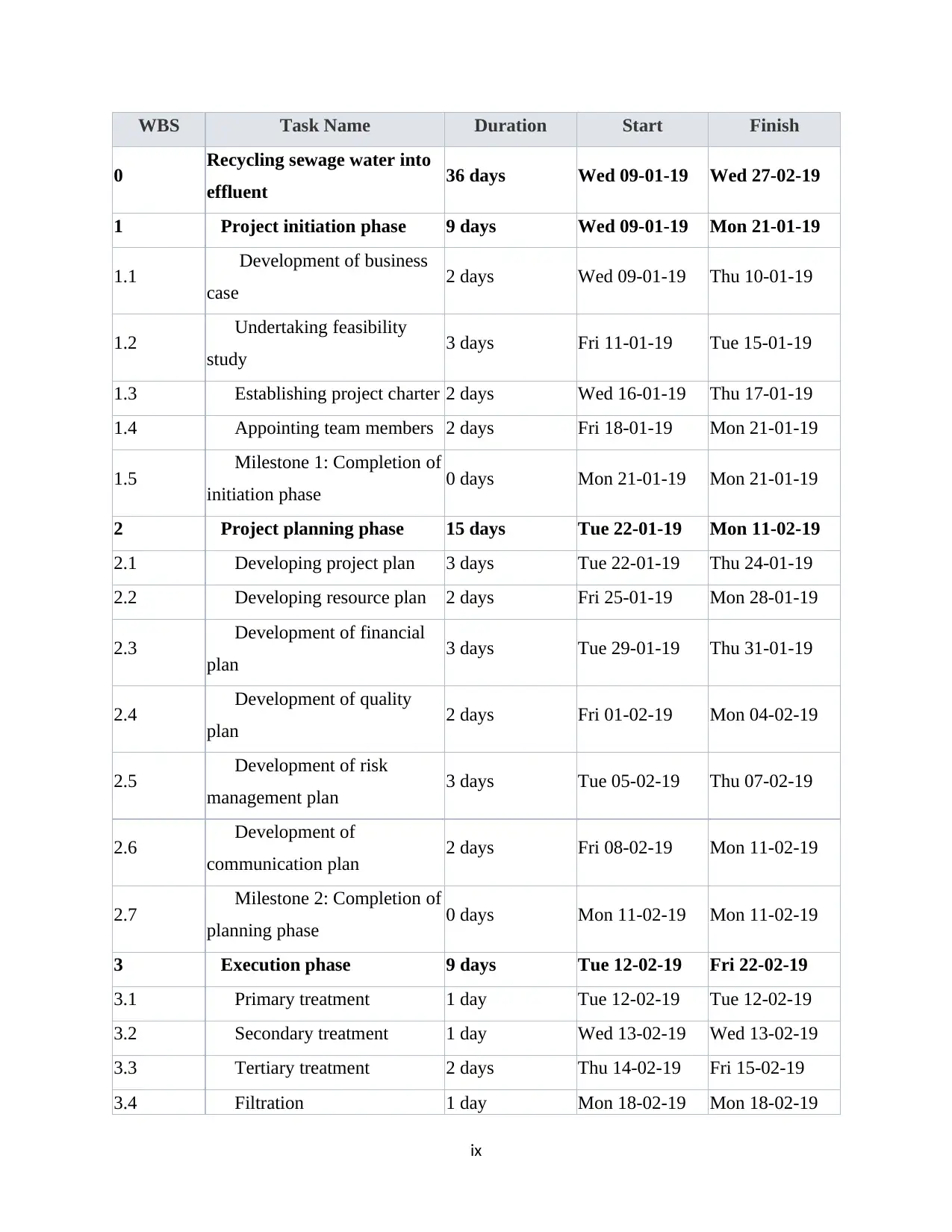
WBS Task Name Duration Start Finish
0 Recycling sewage water into
effluent 36 days Wed 09-01-19 Wed 27-02-19
1 Project initiation phase 9 days Wed 09-01-19 Mon 21-01-19
1.1 Development of business
case 2 days Wed 09-01-19 Thu 10-01-19
1.2 Undertaking feasibility
study 3 days Fri 11-01-19 Tue 15-01-19
1.3 Establishing project charter 2 days Wed 16-01-19 Thu 17-01-19
1.4 Appointing team members 2 days Fri 18-01-19 Mon 21-01-19
1.5 Milestone 1: Completion of
initiation phase 0 days Mon 21-01-19 Mon 21-01-19
2 Project planning phase 15 days Tue 22-01-19 Mon 11-02-19
2.1 Developing project plan 3 days Tue 22-01-19 Thu 24-01-19
2.2 Developing resource plan 2 days Fri 25-01-19 Mon 28-01-19
2.3 Development of financial
plan 3 days Tue 29-01-19 Thu 31-01-19
2.4 Development of quality
plan 2 days Fri 01-02-19 Mon 04-02-19
2.5 Development of risk
management plan 3 days Tue 05-02-19 Thu 07-02-19
2.6 Development of
communication plan 2 days Fri 08-02-19 Mon 11-02-19
2.7 Milestone 2: Completion of
planning phase 0 days Mon 11-02-19 Mon 11-02-19
3 Execution phase 9 days Tue 12-02-19 Fri 22-02-19
3.1 Primary treatment 1 day Tue 12-02-19 Tue 12-02-19
3.2 Secondary treatment 1 day Wed 13-02-19 Wed 13-02-19
3.3 Tertiary treatment 2 days Thu 14-02-19 Fri 15-02-19
3.4 Filtration 1 day Mon 18-02-19 Mon 18-02-19
ix
0 Recycling sewage water into
effluent 36 days Wed 09-01-19 Wed 27-02-19
1 Project initiation phase 9 days Wed 09-01-19 Mon 21-01-19
1.1 Development of business
case 2 days Wed 09-01-19 Thu 10-01-19
1.2 Undertaking feasibility
study 3 days Fri 11-01-19 Tue 15-01-19
1.3 Establishing project charter 2 days Wed 16-01-19 Thu 17-01-19
1.4 Appointing team members 2 days Fri 18-01-19 Mon 21-01-19
1.5 Milestone 1: Completion of
initiation phase 0 days Mon 21-01-19 Mon 21-01-19
2 Project planning phase 15 days Tue 22-01-19 Mon 11-02-19
2.1 Developing project plan 3 days Tue 22-01-19 Thu 24-01-19
2.2 Developing resource plan 2 days Fri 25-01-19 Mon 28-01-19
2.3 Development of financial
plan 3 days Tue 29-01-19 Thu 31-01-19
2.4 Development of quality
plan 2 days Fri 01-02-19 Mon 04-02-19
2.5 Development of risk
management plan 3 days Tue 05-02-19 Thu 07-02-19
2.6 Development of
communication plan 2 days Fri 08-02-19 Mon 11-02-19
2.7 Milestone 2: Completion of
planning phase 0 days Mon 11-02-19 Mon 11-02-19
3 Execution phase 9 days Tue 12-02-19 Fri 22-02-19
3.1 Primary treatment 1 day Tue 12-02-19 Tue 12-02-19
3.2 Secondary treatment 1 day Wed 13-02-19 Wed 13-02-19
3.3 Tertiary treatment 2 days Thu 14-02-19 Fri 15-02-19
3.4 Filtration 1 day Mon 18-02-19 Mon 18-02-19
ix
Paraphrase This Document
Need a fresh take? Get an instant paraphrase of this document with our AI Paraphraser
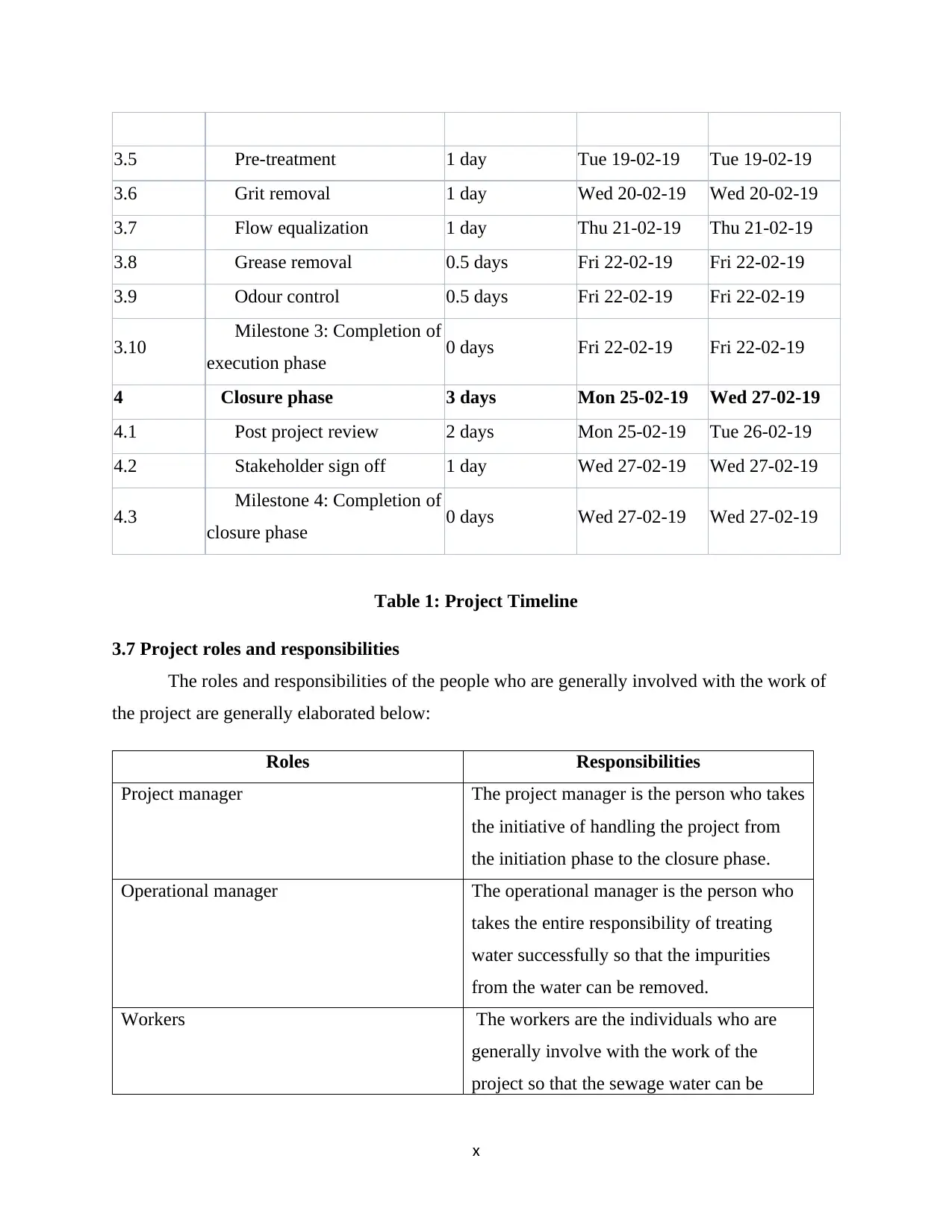
3.5 Pre-treatment 1 day Tue 19-02-19 Tue 19-02-19
3.6 Grit removal 1 day Wed 20-02-19 Wed 20-02-19
3.7 Flow equalization 1 day Thu 21-02-19 Thu 21-02-19
3.8 Grease removal 0.5 days Fri 22-02-19 Fri 22-02-19
3.9 Odour control 0.5 days Fri 22-02-19 Fri 22-02-19
3.10 Milestone 3: Completion of
execution phase 0 days Fri 22-02-19 Fri 22-02-19
4 Closure phase 3 days Mon 25-02-19 Wed 27-02-19
4.1 Post project review 2 days Mon 25-02-19 Tue 26-02-19
4.2 Stakeholder sign off 1 day Wed 27-02-19 Wed 27-02-19
4.3 Milestone 4: Completion of
closure phase 0 days Wed 27-02-19 Wed 27-02-19
Table 1: Project Timeline
3.7 Project roles and responsibilities
The roles and responsibilities of the people who are generally involved with the work of
the project are generally elaborated below:
Roles Responsibilities
Project manager The project manager is the person who takes
the initiative of handling the project from
the initiation phase to the closure phase.
Operational manager The operational manager is the person who
takes the entire responsibility of treating
water successfully so that the impurities
from the water can be removed.
Workers The workers are the individuals who are
generally involve with the work of the
project so that the sewage water can be
x
3.6 Grit removal 1 day Wed 20-02-19 Wed 20-02-19
3.7 Flow equalization 1 day Thu 21-02-19 Thu 21-02-19
3.8 Grease removal 0.5 days Fri 22-02-19 Fri 22-02-19
3.9 Odour control 0.5 days Fri 22-02-19 Fri 22-02-19
3.10 Milestone 3: Completion of
execution phase 0 days Fri 22-02-19 Fri 22-02-19
4 Closure phase 3 days Mon 25-02-19 Wed 27-02-19
4.1 Post project review 2 days Mon 25-02-19 Tue 26-02-19
4.2 Stakeholder sign off 1 day Wed 27-02-19 Wed 27-02-19
4.3 Milestone 4: Completion of
closure phase 0 days Wed 27-02-19 Wed 27-02-19
Table 1: Project Timeline
3.7 Project roles and responsibilities
The roles and responsibilities of the people who are generally involved with the work of
the project are generally elaborated below:
Roles Responsibilities
Project manager The project manager is the person who takes
the initiative of handling the project from
the initiation phase to the closure phase.
Operational manager The operational manager is the person who
takes the entire responsibility of treating
water successfully so that the impurities
from the water can be removed.
Workers The workers are the individuals who are
generally involve with the work of the
project so that the sewage water can be
x
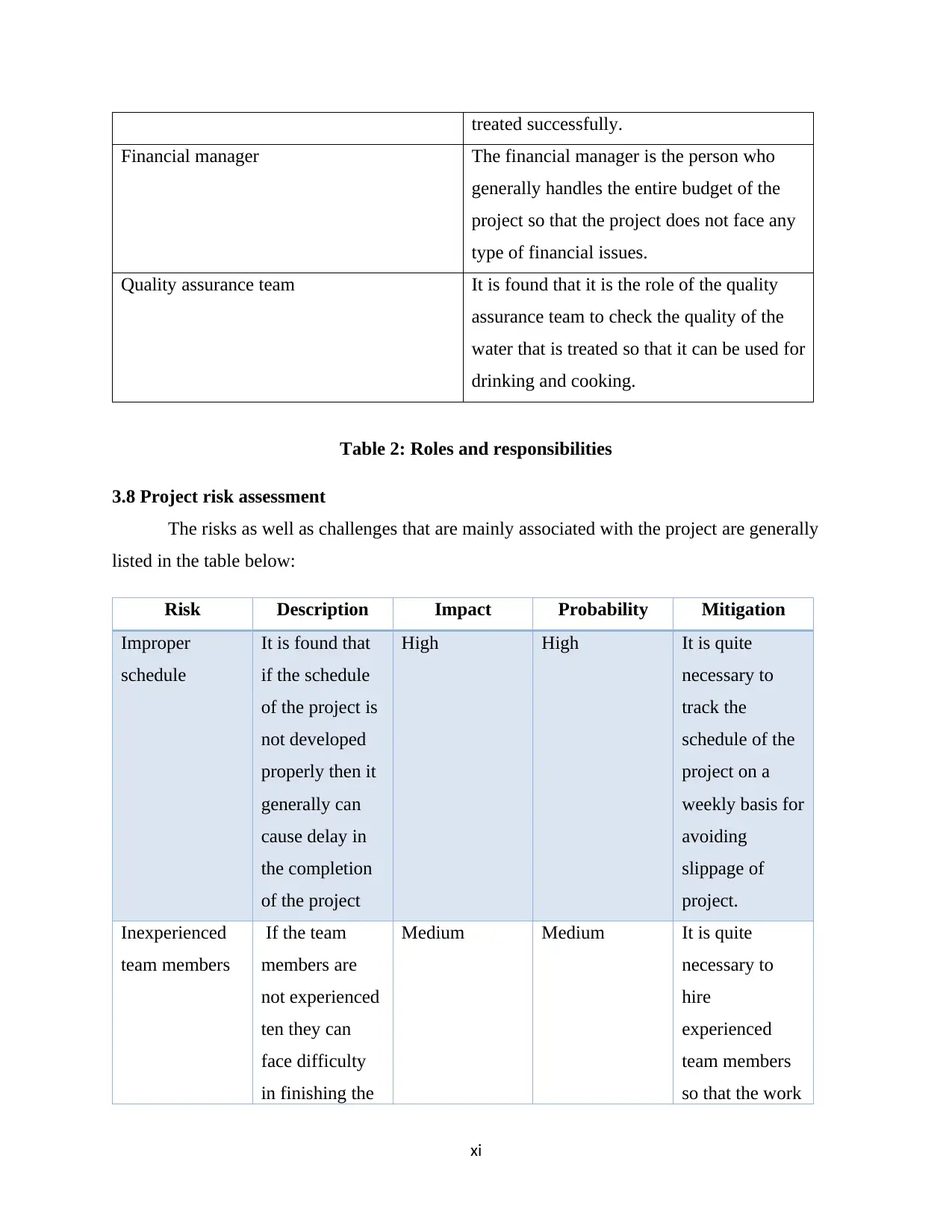
treated successfully.
Financial manager The financial manager is the person who
generally handles the entire budget of the
project so that the project does not face any
type of financial issues.
Quality assurance team It is found that it is the role of the quality
assurance team to check the quality of the
water that is treated so that it can be used for
drinking and cooking.
Table 2: Roles and responsibilities
3.8 Project risk assessment
The risks as well as challenges that are mainly associated with the project are generally
listed in the table below:
Risk Description Impact Probability Mitigation
Improper
schedule
It is found that
if the schedule
of the project is
not developed
properly then it
generally can
cause delay in
the completion
of the project
High High It is quite
necessary to
track the
schedule of the
project on a
weekly basis for
avoiding
slippage of
project.
Inexperienced
team members
If the team
members are
not experienced
ten they can
face difficulty
in finishing the
Medium Medium It is quite
necessary to
hire
experienced
team members
so that the work
xi
Financial manager The financial manager is the person who
generally handles the entire budget of the
project so that the project does not face any
type of financial issues.
Quality assurance team It is found that it is the role of the quality
assurance team to check the quality of the
water that is treated so that it can be used for
drinking and cooking.
Table 2: Roles and responsibilities
3.8 Project risk assessment
The risks as well as challenges that are mainly associated with the project are generally
listed in the table below:
Risk Description Impact Probability Mitigation
Improper
schedule
It is found that
if the schedule
of the project is
not developed
properly then it
generally can
cause delay in
the completion
of the project
High High It is quite
necessary to
track the
schedule of the
project on a
weekly basis for
avoiding
slippage of
project.
Inexperienced
team members
If the team
members are
not experienced
ten they can
face difficulty
in finishing the
Medium Medium It is quite
necessary to
hire
experienced
team members
so that the work
xi
⊘ This is a preview!⊘
Do you want full access?
Subscribe today to unlock all pages.

Trusted by 1+ million students worldwide
1 out of 21
Related Documents
Your All-in-One AI-Powered Toolkit for Academic Success.
+13062052269
info@desklib.com
Available 24*7 on WhatsApp / Email
![[object Object]](/_next/static/media/star-bottom.7253800d.svg)
Unlock your academic potential
Copyright © 2020–2025 A2Z Services. All Rights Reserved. Developed and managed by ZUCOL.



